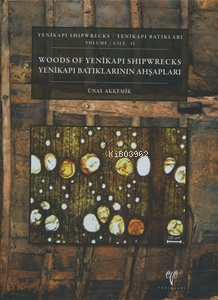9786054701872
609156

https://www.sehadetkitap.com/urun/yenikapi-batiklari-cilt-ii-yenikapi-batiklarinin-ahsaplari-yenikapi-shipwrecks-volume-ii-woods-of-yenikapi-shipwrecks
Yenikapı Batıkları Cilt II ;Yenikapı Batıklarının Ahşapları / Yenikapı Shipwrecks Volume II - Woods of Yenikapı Shipwrecks
1000.00
Salvage excavations conducted at Yenikapı within the frame of Marmaray and Metro projects brought to light the Theodosian Harbour and rare archaeological remains. The new finds that extended Istanbul's history to 8000 BP include an assembly of 37 shipwrecks dated to the fifth through eleventh centuries AD. This book deals with the genus-species identifications of 27 shipwrecks unearthed by Istanbul Archaeological Museums Directorate and processed by the Division of Conservation of Marine Archaeological Objects, Faculty of Letters, Istanbul University. More than 3000 samples were analysed by Prof. Dr. Ünal Akkemik of Istanbul University's Faculty of Forestry. All the shipwrecks uncovered belong to the Byzantine period; however, those of the fifth-seventh centuries were built with coniferous trees like cypress and pine whereas those of the ninth-eleventh centuries were built with broad-leaved trees like oak and chestnut. Ships of the seventh-ninth centuries, on the other hand, reflect a mixture of both tree groups. In overall, the wood identifications indicate a change from the coniferous trees to broad-leaved trees in the time span of fifth to eleventh centuries. Study of the 27 wrecks has not only cast light onto the shipbuilding techniques of the Byzantine period but also produced an invaluable database revealing the change in woods used.
Salvage excavations conducted at Yenikapı within the frame of Marmaray and Metro projects brought to light the Theodosian Harbour and rare archaeological remains. The new finds that extended Istanbul's history to 8000 BP include an assembly of 37 shipwrecks dated to the fifth through eleventh centuries AD. This book deals with the genus-species identifications of 27 shipwrecks unearthed by Istanbul Archaeological Museums Directorate and processed by the Division of Conservation of Marine Archaeological Objects, Faculty of Letters, Istanbul University. More than 3000 samples were analysed by Prof. Dr. Ünal Akkemik of Istanbul University's Faculty of Forestry. All the shipwrecks uncovered belong to the Byzantine period; however, those of the fifth-seventh centuries were built with coniferous trees like cypress and pine whereas those of the ninth-eleventh centuries were built with broad-leaved trees like oak and chestnut. Ships of the seventh-ninth centuries, on the other hand, reflect a mixture of both tree groups. In overall, the wood identifications indicate a change from the coniferous trees to broad-leaved trees in the time span of fifth to eleventh centuries. Study of the 27 wrecks has not only cast light onto the shipbuilding techniques of the Byzantine period but also produced an invaluable database revealing the change in woods used.
Yorum yaz
Bu kitabı henüz kimse eleştirmemiş.











